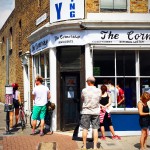People attract people. This statement was first coined by William H. Whyte in his detailed study of The Social Life of Small Urban Spaces. Whyte attributes the ‘people attraction’ behaviour to a number of factors but most surprisingly he found people ‘self-congest’. People like busy places. He observed how conversations tended to happen in places with the greatest pedestrian flows and the densest opportunities for encounter; on street corners, along main pedestrian paths, in the middle of a traffic stream, near objects like statues or fountains, along a curb. In short, people’s movements are one of the greatest spectacles of a place. People like to watch other people. People are drawn to places where other people go. It is this type of behaviour, and its location on busy pathways, that is conducive to ‘hanging out’.
What is a hang out?
What is it about places that attract people? This blog is about neighbourhood ‘hangouts’ – places where people from different cultures meet. Hangouts are meeting places. Every vibrant and cohesive neighbourhood should have a few hangouts where everyone feels welcome and can strike up a conversation with their neighbour. Sociologist Ray Oldenburg calls neighbourhood hangouts a ‘third place’; places that are for socialising and are relaxing and fulfilling. They are places that balance between domestic and work life. Oldenburg’s central thesis is that increasingly contemporary domestic life consists of isolated nuclear families or single people living alone. The work environment is similarly solitary, anti-social and competitive. Oldenburg argues people need the release and stimulation that more sociable realms provide. His term ‘third place’ signifies ‘the great variety of public places that host regular, voluntary, informal and happily anticipated gatherings of individuals beyond the realms of home and work’. Third places are often specific to cultures such as the pub in the UK, outdoor cafes in French and Italian towns, coffee houses in Austrian cities, and beer gardens in Germany. More recently, third places accommodate multiple complimentary uses that together increase footfall and attraction; for example the location of Starbucks coffee shops in bookstores.
For Oldenburg the core qualities of third places are:
- Being ‘neutral ground’, where individuals can come and go as they please
- Being highly inclusive, accessible and without formal criteria of membership
- Their ‘taken-for-granted-ness’ and low profile
- Being open during and outside office hours
- Being characterised by a ‘playful mood’
- Providing psychological comfort and support
- With conversation their ‘cardinal and sustaining’ activity, providing ‘political fora of great importance’
In every neighbourhood there are either existing places or places of potential which could be transformed into neighbourhood hangouts. These are public spaces that help bridge differences through associations and intercultural contact. The next section examines how a neighbourhood space can become a hangout.
What are the conditions for a successful hang out?
Many community-building processes are based on creating third places. Third places are most successfully created by ‘triangulation’: this simply refers to the way elements in a public place build on one another, creating something more than the sum of its parts. It is synergy. PPS calls this synergy the ‘Power of Ten’, meaning that if there are at least ten things you can do in a particular spot, it will likely become a popular destination for people in the neighborhood. As an example they describe this scenario: ‘Take a humble spot in your neighborhood – a bus stop or a branch library – and consider how you could gradually fashion it into a hub of public activity. Add a bench to the bus stop, then a trash receptacle and a drinking fountain, and it changes the whole feel of the corner. A regular Saturday morning story time, along with a community message board out front and a playground for tots, transforms the library into a community center. Then see what happens at either location when a coffee shop with sidewalk tables opens, some public art is created, and vendors arrive selling ice cream or garden produce. Voilà! You’ve got a great hangout, a place you’ll visit even when you’re not taking the bus or looking for a book. You show up because you know something will be happening there’.
In her study of the ‘superdiverse’ London Borough of Hackney, Susanne Wessendorf, describes the parochial realm. She characterizes the parochial realm by more communal relations among neighbours, with colleagues in the workplace, or acquaintances through associations or schools. What distinguishes the public realm, in her view, is that in the public realm people meet strangers, whereas in the parochial realm, like a corner shop or a market where traders and customers meet on a regular basis, social relations become habitual and frequent. The differentiation between the public, parochial and private realm is particularly useful when thinking about the degree to which interactions between people of different backgrounds are meaningful and contribute to intercultural understanding. She describes how the weekly coffee morning in the local primary school creates opportunities to socialise with people of diverse backgrounds. The mothers attending the coffee morning emphasised that having children facilitated social contacts with other parents. Conversations often focused on those shared interests like gardening, cooking and education, rather than their differences. Wessendorf concludes by saying: ‘while not talking about difference could be interpreted as a way to avoid tensions, it could also be explained with the existence of a general acceptance of people who are different and a sense that as long as people interact and are friendly, things are fine.’
Another ethnographic study of ‘Nick’s Caff’ on the Walworth Road in London by Suzanne Hall describes the importance of this meeting place to the local neighbourhood. Hall talks about the Caff as a place where ‘foreigner’ and ‘local’ sit literally and conceptually at the same table. Nick, the café owner, is a second generation migrant from Cyprus. His father opened the Caff in the 1960s, and it has become a regular and sustained institution on the Walworth Road throughout the demographic changes. Today it is a superdiverse neighbourhood. The study showed how socially organised the Caff is spatially and temporally. It allows people to claim a place to sit within the ‘rhythm of the day’. Hall records the ‘performances’ that regulate conversations, eye contact, distance, and intimacy. She notes ‘the caff was a place to go to regularly, either spontaneously or as part of a routine. It was a place where one could do nothing much without being moved on; there was no institutional setting or formal membership required for being there. One may go through the formality of ordering a cup of tea, but more importantly the Caff was a place where one could spend time and take your time.’ What both studies of Hackney and the Walworth Road show is the importance of places accommodating opportunities to linger and that provide a shared interest.
The Power of Ten concept has transformed the perceptions of public spaces. One case study is a street in New Haven where a meeting place was created by a savvy developer, Joel Schiavone. Chapel Street in the downtown of New Haven, Connecticut, had by the 1980s suffered severe urban decline with only five percent of the area’s residential and commercial spaces being occupied. Schiavone was inspired to invest in a number of small interventions without making the street look radically different. He convinced city officials to undo the damage of an earlier street-widening project by expanding the pavements so that Chapel Street felt like a place you’d want to hang out. As a result, a café expanded with outdoor seating, then two more cafés opened, and a newspaper vendor set up shop. Today, Chapel Street is thriving, a hub for people to use the place throughout the day and week. As a result of uses that began to attract footfall, other establishments began to have confidence in opening up leading to the opening of nightclubs, restaurants, several theatres, and shops selling everything from bicycles to jewelry. ‘The whole thing is like a mosaic,’ Schiavone explains. ‘Each piece needs to be carefully considered: street furniture, flowerboxes, a particular tenant for a storefront, tree plantings. If it’s done right, all these things come together to create a real neighborhood.’
Noha is author of the book ‘Bridging Cultures: the guide to social innovation in cosmopolitan cities’ available on Amazon at http://www.amazon.co.uk/Bridging-Cultures-Social-Innovation-Cosmopolitan/dp/1517157188

